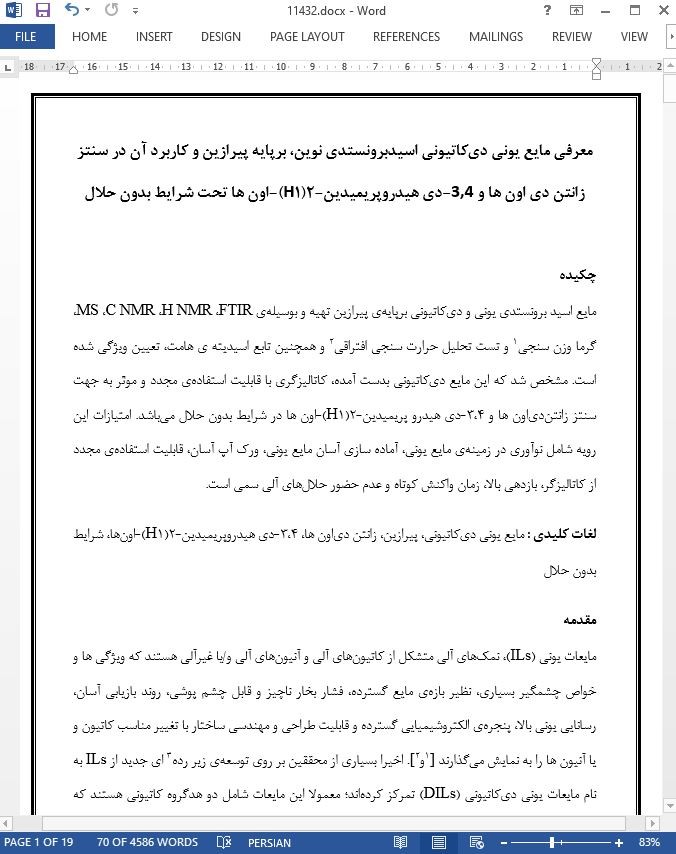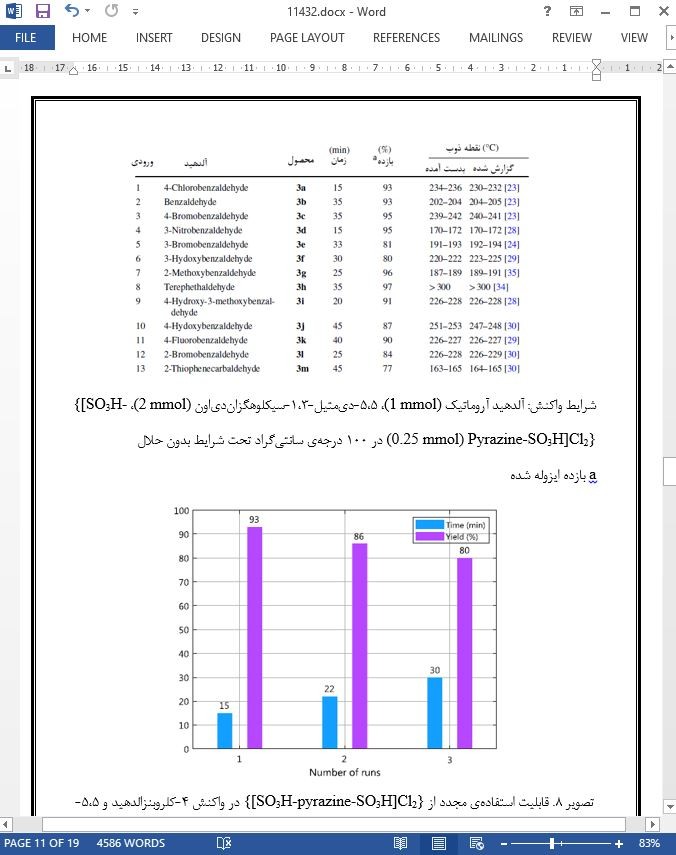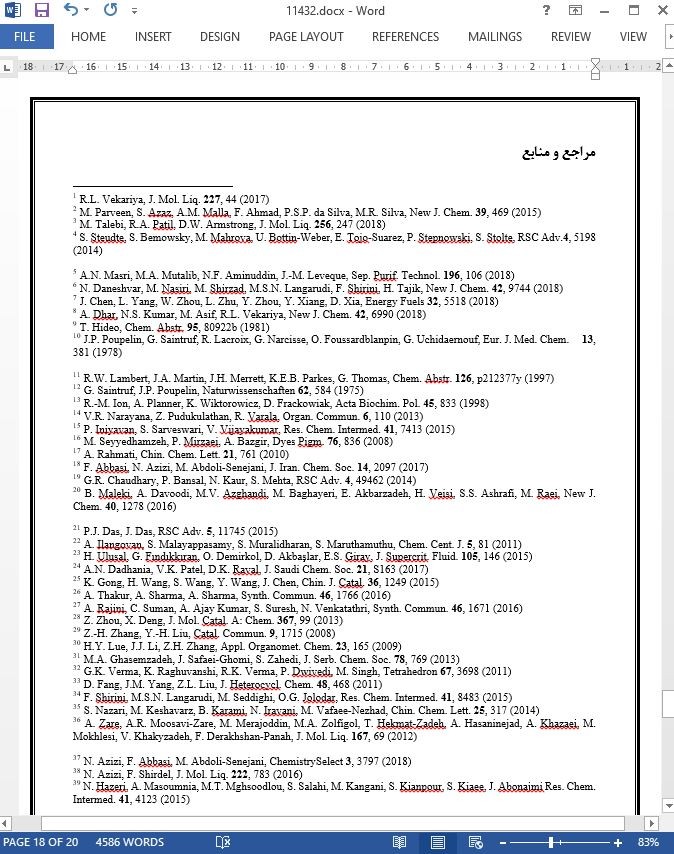
معرفی مایع یونی دی کاتیونی اسیدبرونستدی نوین، برپایه پیرازین و کاربرد آن در سنتز زانتن دی اون ها
چکیده
مایع اسید برونستدی یونی و دیکاتیونی برپایهی پیرازین تهیه و بوسیلهی FTIR، H NMR، C NMR، MS، گرما وزن سنجی و تست تحلیل حرارت سنجی افتراقی و همچنین تابع اسیدیته ی هامت، تعیین ویژگی شده است. مشخص شد که این مایع دیکاتیونی بدست آمده، کاتالیزگری با قابلیت استفادهی مجدد و موثر به جهت سنتز زانتندیاون ها و 3،4-دی هیدرو پریمیدین-2(1H)-اون ها در شرایط بدون حلال میباشد. امتیازات این رویه شامل نوآوری در زمینهی مایع یونی، آماده سازی آسان مایع یونی، ورک آپ آسان، قابلیت استفادهی مجدد از کاتالیزگر، بازدهی بالا، زمان واکنش کوتاه و عدم حضور حلالهای آلی سمی است.
مقدمه
مایعات یونی (ILs)، نمکهای آلی متشکل از کاتیونهای آلی و آنیونهای آلی و/یا غیرآلی هستند که ویژگی ها و خواص چشمگیر بسیاری، نظیر بازهی مایع گسترده، فشار بخار ناچیز و قابل چشم پوشی، روند بازیابی آسان، رسانایی یونی بالا، پنجرهی الکتروشیمیایی گسترده و قابلیت طراحی و مهندسی ساختار با تغییر مناسب کاتیون و یا آنیون ها را به نمایش میگذارند [1,2]. اخیرا بسیاری از محققین بر روی توسعهی زیر رده ای جدید از ILs به نام مایعات یونی دیکاتیونی (DILs) تمرکز کردهاند؛ معمولا این مایعات شامل دو هدگروه کاتیونی هستند که توسط یک اسپیسر صلب یا منعطف به یکدیگر متصل شده و با دو آنیون مخالف ارتباط دارند [3]. در مقایسه با ILs تک کاتیونی، چند کاتیونی ها دارای نقطهی ذوب، ویسکوزیته، کشش سطحی و پایداری حرارتی بالاتری بوده، بازهی مایع گسترده تری داشته و از ثبات خواص فیزیکی و شیمیایی بیشتری برخوردارند [4,5]. به همین دلیل این مایعات بازهی بکارگیری گستردهای دارند؛ از جمله سل های خورشیدی، سل های سوختی، باتریها، روان کارها، محیطهای واکنش، فناوری جداسازی، آماده سازی مواد، واکنشهای کاتالیزوری و جدیدترین آنها، بهبود درجهی ایزومری شدن n-pentane و الکترولیتها برای عکس برداری [6,7,8].
نتیجه گیری
ما در این تحقیق و پژوهش، آماده سازی، تعیین ویژگی و کاربرد کاتالیزوری {[SO3H-pyrazine-SO3H]Cl2} در سنتز زانتندیاون ها و DHPMs را تحت شرایط بدون حضور حلال شرح دادیم. سهولت در امر آماده سازی و کنترل کاتالیزگر، عمومیت، سهولت در فرآیند ورک آپ، بازده بالا، مدن زمان کوتاه واکنش، قابلیت استفادهی مجدد از کاتالیزگر و عدم حضور حلال های آلی از جمله موارد قابل توجه توسعهی این روند میباشند.
Abstract
A novel dicationic Brönsted acidic ionic liquid based on pyrazine has been prepared and characterized by FTIR, 1 H NMR, 13C NMR, MS, thermal gravimetric and differential thermal gravimetric analysis and also Hammett acidity function. The prepared dicationic ionic liquid is found to be an efcient and reusable catalyst for the synthesis of xanthenediones and 3,4-dihydropyrimidin-2(1H)-ones under solventfree conditions. The merits of the developed procedure include novelty in terms of the ionic liquid, easy preparation of the ionic liquid, easy workup, reusability of the catalyst, high yield, short reaction time and absence of toxic organic solvent.
Introduction
Ionic liquids (ILs) are organic salts comprised of organic cations in combination with organic and/or inorganic anions, which exhibit a myriad of remarkable and interesting properties, such as wide liquid range, negligible vapor pressure, simple recovery process, high ionic conductivity, broad electrochemical window and design ability by appropriate modifcations of cations or anions in structures [1, 2]. Recently, many researches have been focusing on the development of a new subclass of ILs known as dicationic ionic liquids (DILs), which typically consist of two cationic head groups linked by a rigid or fexible spacer, associated with two counteranions [3]. Compared to monocationic ILs, multicationic ones can have a higher melting point, viscosity, surface tension, thermal stability, wide liquid range and tenability of chemical and physical properties [4, 5]. Therefore, they have good potential to be used in a wide range of applications including solar cells, fuel cells, batteries, lubricants, reaction media, separation technologies, material preparation, catalysis reactions and, more recently, improving the isomerization degree of n-pentane and electrolytes for photo-harvesting [6–8].
Conclusion
In this research, we have described the preparation, characterization and catalytic application of {[SO3H–Pyrazine–SO3H]Cl2} in the synthesis of xanthenediones and DHPMs under solvent-free conditions. Ease of preparation and handling of the catalyst, generality, easy workup procedure, high yields, short reaction times, reusability of catalyst and absence of organic solvents are the attractiveness of the developed procedure.
چکیده
مقدمه
بخش تجربی
آماده سازی و تهیهی کاتالیزور ها
تعیین ساختار کاتالیزور
FTIR
HNMR
CNMR
Mass Spectrum
TG/DTA
تابع اسیدیتهی هامت
نتایج و بحث
فرآیند عمومی جهت سنتز زانتندیاون ها تحت شرایط بدون حضور حلال
فرآیند کلی برای سنتز DHPMs تحت شرایط بدون حضور حلال
داده های طیفی برخی از ترکیبات منتخب
نتیجه گیری
Abstract
Introduction
Experimental section
Preparation of the catalyst
Determination of the structure of the catalyst
FTIR
H NMR
C NMR
Mass spectrum
TG/DTA
Hammett acidity function
Results and discussion
General procedure for the synthesis of xanthenediones under solvent free conditions
General procedure for the synthesis of DHPMs under solvent free conditions
Spectra data of some selected compounds
Conclusion
- اصل مقاله انگلیسی با فرمت ورد (word) با قابلیت ویرایش
- ترجمه فارسی مقاله با فرمت ورد (word) با قابلیت ویرایش، بدون آرم سایت ای ترجمه
- ترجمه فارسی مقاله با فرمت pdf، بدون آرم سایت ای ترجمه



